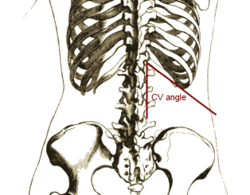Costovertebral angle
Appearance
| Costovertebral angle | |
|---|---|
 View of the human skeleton from the back; the costovertebral angle is marked. | |
| Details | |
| Identifiers | |
| Latin | arcus costovertebralis |
| Anatomical terminology | |

The costovertebral angle (Latin: arcus costovertebralis) is the acute angle formed on either side of the human back between the twelfth rib and the vertebral column.[1]
The kidney lies directly below this area, so is the place where, with percussion (Latin: sucussio renalis), pain is elicited when the person has kidney inflammation. The presence of pain is marked as a positive Murphy's punch sign or as costovertebral angle tenderness.[2]
References
[edit]- ^ "Costovertebral Angle - Medical Definition". Lippincott Williams & Wilkins. Retrieved 13 June 2012.
- ^ Musana KA, Yale SH (August 2005). "Murphy's Sign". Clin Med Res. 3 (3): 132. doi:10.3121/cmr.3.3.132. PMC 1237152. PMID 16160065.
